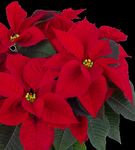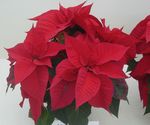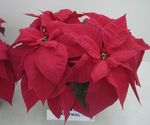Poinsettia Temperature Management after Flower Induction
←
→
Page content transcription
If your browser does not render page correctly, please read the page content below
Mirage™ RedCaption
Poinsettia Temperature
Management after Flower Induction
Managing temperatures correctly after flower induction is vital to plant health and grower success. Along
with maintaining adequate greenhouse temperatures, growers should continue to scout and protect against
disease with preventive treatments. Read the tips below for information on day and night temperatures,
timing, disease protection, cold growing/finishing and how to apply this knowledge to different poinsettia
varieties.
I D E A L T E M P E R AT U R E
For all varieties, temperatures at 68–73 °F
(20–23 °C) and 66–68 °F (19–20 °C) are ideal
for day and night until two to three weeks
prior to shipping. Toward the end of the crop,
slowly drop the temperature down to 65 °F
(18 °C) during the day and night for medium-
green leaf varieties and 61–62 °F (16 °C) night
temperatures for dark leaf varieties. Many
darkleaf white varieties develop a creamy
white bract color if finished at temperatures
below 68 °F (20 °C) at night. Bracts of Cortez™
Burgundy poinsettia can get a waxy sheen
at temperatures below 65 °F (18 °C), so this
variety should be finished at night temperatures Photo 1. Late season Botrytis infection on white varieties due to high relative
above 66 °F (19 °C). With cooler night humidity (above 75%), poor air circulation, and lack of fungicide treatments.
temperatures during the last 2–3 weeks, bracts
will generally be smaller and more upright, the colors more intense, and the flowering delayed from several
days up to one week.
If plants are grown under cooler temperatures, they should be planted and
pinched about one week earlier than usual. Watch for Botrytis on leaves and
bracts and inspect roots regularly when finished under cool temperatures.
Spray with fungicides, such as Mural® and Palladium® fungicides (with
CapSil® surfactant if used on bracts to avoid residue) if necessary. White
varieties (e.g., Whitestar™, Alpina™ White, Biancaneve™ White, Alaska™
White, Virgo™ White poinsettia, etc.) are generally the first to show signs of
lateseason Botrytis infections (Photo 1) and should be sold within a week
of being finished.Cool Morning Dip: Drop temperatures by 5°F (or 8–10 °F if humidity is low) for two to three hours before
sunrise. In case of high day time temperatures (greater than 76 °F/24 °C), balance with a cool morning
approach and growth regulator treatments.
Negative DIF: Temperatures at 65 °F/18 °C during the day and 68 °F and during the night would work well
to reduce the growth of poinsettias without running into Botrytis problems, which are often caused by low
night temperatures combined with high humidity.
COLD GROWING AND FINISHING
Syngenta Flowers conducted extensive trials across North America with many varieties to better understand
the effects of cold growing/finishing on growth and flowering. View more information on cold growing
here.
Cold growing/finishing yields fuel savings, less chemical growth regulation, lower insect pressure and
sturdier plants, but care must be taken when growing/finishing cold. Some colors, such as reds, pinks, and
marbles, intensify; however, whites become creamier. Be conservative with low temperatures and don’t go
below 60°F (16°C) for any significant length of time. Temperatures that are too low can dramatically delay
flowering and reduce bract size. Run trials first by lowering average temperatures just a few degrees below
conventional warmgrowing protocols. Adjust crop schedules and planned market dates as coldgrown
plants will be significantly delayed.
VARIETY SELECTION
The best varieties for cold growing/finishing are those that have early flower response times, good vigor,
naturally large bracts and strong root systems. An excellent variety for cold growing is Early Orion™ Red
poinsettia. This variety maintains adequate height and bract size under relatively low temperatures (e.g.,
62°F average daily temperature) beginning in earlymid October (Photo 2). Refer to Syngenta’s poinsettia
catalog for a complete list of varieties that can be grown cold or finished cool.
Orion™ Early Red
Control | 70 °F / 21 °C ADT October 5 | 62 °F / 16.5 °C ADT
Sale Date: November 5 Sale Date: November 20
Orion™ Early Orion comparison: Warm versus cold finishing. Bract coloring is about two weeks delayed and
color enhanced with average daily temperatures of 62 °F starting October 5th (plant on the right).
2 | POI N SET T I A T EMPER A T UR E M A NA GE M E NT A F T E R F L O WE R I N DU C T I ONI R R I G AT I O N Monitor irrigation closely and do not overwater plants. With colder temperatures, plants use less water, and pots stay wetter longer. Monitor roots regularly and apply preventative fungicides if needed. Also watch for Botrytis on those varieties that are more prone to infection. PLANT GROWTH MANAGEMENT Reduce early chemical growth regulation. Compared to normal “warm” growing, the use of plant growth regulators can be reduced. Do not put an overly growthregulated plant into a cold environment. Try to keep the plant at the top of its height tracking curve before lowering temperatures. Cold growing/finishing results in shorter plants, so be sure to schedule plenty of time to get the plant up to size before entering the cold temperature regime. It is best to wait until the middle of October and the beginning of bract coloration before dropping temperatures. Use the natural warmth of August and September to build the plant, and the naturally cool periods of October and November to save fuel. The later plants go into the cold environment in October, the less height, bract size, and flower timing will be affected. Monitor irrigation closely and do not overwater plants. With colder temperatures, plants use less water, and pots stay wetter longer. Monitor roots regularly and apply preventative fungicides if needed. Also watch for Botrytis on those varieties that are more prone to infection Poinsettia Open House Trials, Millstadt, IL, November 2019 All photos are either the property of Syngenta or are used with permission. © 2021 Syngenta. Important: Always read and follow label instructions. Some products may not be registered for sale or use in all states or counties and/or may have state-specific use requirements. Please check with your local extension service to ensure registration and proper use. Some or all of the varieties may be protected under one or more of the following: Plant Variety Protection, United States Plant Patents and/or Utility Patents and may not be propagated or reproduced without authorization. The trademarks displayed or otherwise used herein are the property of their respective owners.
You can also read























































